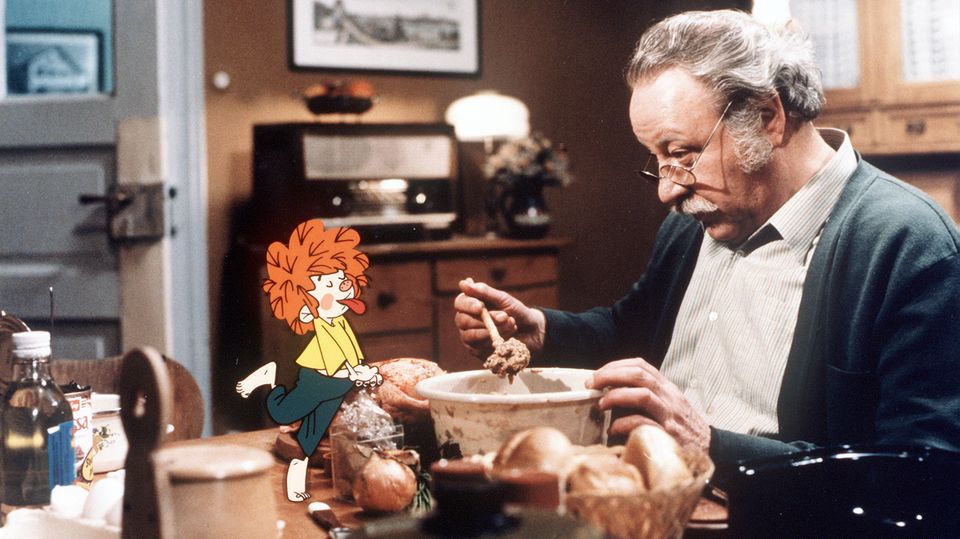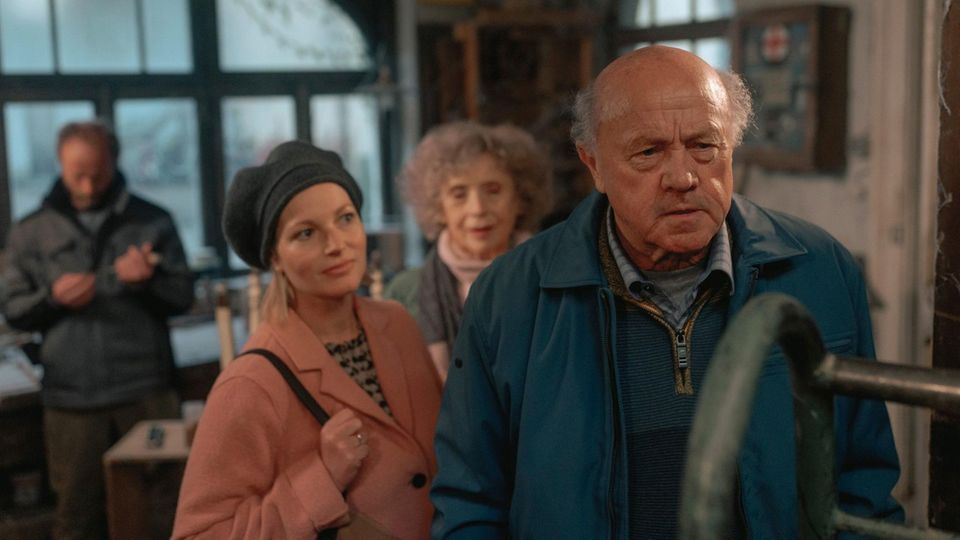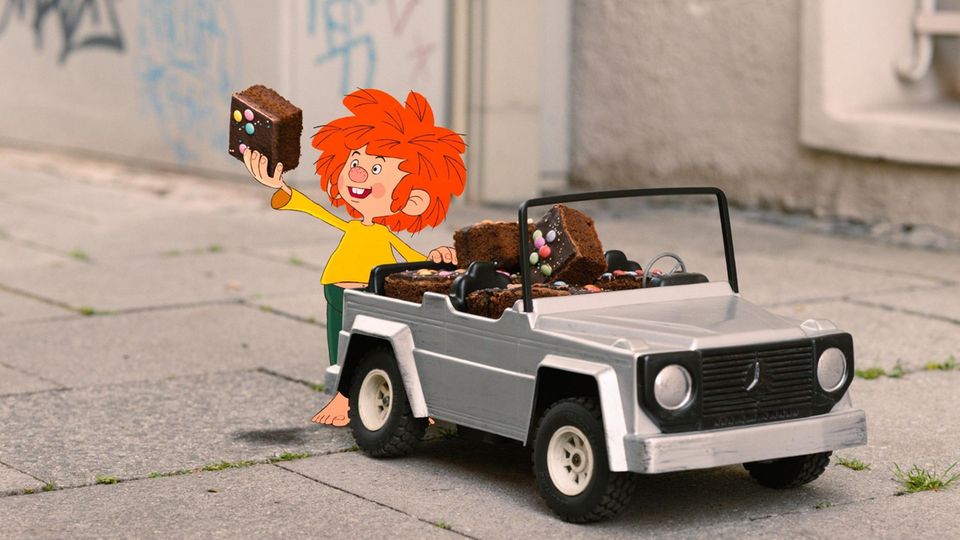Our author was excited and a little skeptical waiting for the new edition of his former favorite children’s series. Now the “New Stories from Pumuckl” can be seen. His first conclusion: A small miracle has happened.
I was in my early 30s when I first moved to Munich, a city where I had never spent more than a few hotel nights at a time. And yet it felt like I had returned home.
We children of the 70s and 80s all grew up a bit in Munich. The reason for this is a goblin named Pumuckl. We knew the special charm of the backyards of the Bavarian capital, and in the 52 episodes of the extremely popular series we had gotten to know the special Munich characters and facts that made up this special city: the argumentative Bernbacher, the superstitious Mrs. Eichinger, Mr. and Mrs. Stürtzlinger and of course the grumpy and lovable Master Eder himself. The old tongue-lashing, which today – “Kreizbirnbamstaun!” – has unfortunately become less common, was as familiar to us as it was ours own grandparents.

© United Archives GmbH
In general, back then, life in German series seemed to take place primarily in Munich. Against the city, the master Eder, the team from Police Inspectorate 1, produced the Monaco Franze and the Baby Schimmerlos, even metropolises like Berlin or Hamburg seemed to have difficulty keeping up. Somehow and anyway, Munich was the place of longing for those years.
The old Munich no longer exists
Until the year 2005, when I was supposed to move to the real Munich, Pumuckl and I had lost touch. Once I visited my friend Malte, who had moved to Widenmayerstrasse 2 on the Isar, and was amazed to see the inner courtyard of the Eder carpentry shop – unfortunately without the familiar porch with the carpentry shop, which had long since been demolished. Only with a lot of imagination could the old inner courtyard be mentally reconstructed.

© Image Broker/Action Press
But then I moved into an old house in Schwabing that didn’t house a carpenter’s shop, but did house a porcelain clinic. Mr. Deesy, the master of gluing together broken coffee mugs as well as reconstructing art-historically valuable but battered porcelain vases, was not a gnarled Bavarian like Gustl Bayerhammer, but a Hungarian who was no less adept at grumbling. The setting of his backyard workshop and the many lovable, bizarre Munich characters who came and went there were similar and awakened my old Pumuckl love in me. It wouldn’t have surprised me for a second if Mr. Deesy had one too Goblin would have hopped around between all the Nymphenburg porcelain angels.
Since December 10th, the big risk of telling new stories about Pumuckl has been running on RTL+. There’s just one problem that the producers can’t really do anything about: the Munich of yesteryear, which people would have loved to visit again with the Pumuckl, hardly exists anymore. Ateliers of designers such as Stefan Diez and Ingo Maurer have moved into the old backyard workshops.
Reunion with Munich figures and facts
And then this series works, straight away. This is certainly due to Markus H. Rosenmüller from Tegernsee (“He who dies earlier is dead longer”), the director who seems to understand the Bavarian nature most closely and knows the city and its soul. When in episode two a parcel delivery man turns the carpenter’s shop into a storage location for the entire Eder neighborhood, it immediately brings back memories of similar situations with my former neighbor Mr. Deesy. When my mother once visited me on Clemensstrasse, she met him and immediately greeted him as the famous porcelain doctor. He answered with a wonderful Hungarian accent: “I’m only a porcelain doctor part-time, my full-time job is post office for your son.”
The production company “Neue Super” was able to compensate for the loss of the old original building with an elaborate set construction on the outskirts of Munich. The famous courtyard was perfectly reconstructed there and then made old and dusty again “with mysterious ingredients,” as art director Carl Oberweisebuchner says, “so that the paint peels off.” The canopy, the dachshund figure at the entrance, the rickety workshop door with the slats falling over, the little Pumuckl bed and the swing ship, everything is back, wobbling, squeaking and dusting like before. But who should replace the master Eder, who was so brilliantly embodied by the popular actor Gustl Bayrhammer, who died in 1993? The attempt at a new edition in 1999 with Towje Kleiner, who traveled as the ship’s cook Odessi with a sloppily drawn version of the goblin, failed miserably.
Voice from beyond – using AI
We seem to have learned from this: The Pumuckl from the “New Stories” is a small masterpiece, perfectly implemented and unmistakably himself. Barbara von Johnson, who won the tender as a student in the 80s and designed the original Pumuckl, stood as Grande Dame with wet eyes Godfather. This time, cabaret artist Maxi Schafroth croaks the goblin’s voice; artificial intelligence is used to give it the special timbre of Hans Clarin, who fell silent forever in 2005. Unfortunately, his quick and cheeky intelligence cannot be brought back; the new Pumuckl lacks it a little in some places. The current goblin is also a bit rusty when it comes to rhyming. But as a character he remains the one you knew as a child – and so there is a real reunion.
Reunion with Pumuckl actors from the old series: Ilse Neubauer (M.) returns in her role as Mrs. Stürtzlinger, Hans Stadlbauer was still there as a postman in 1988, in 2023 he will play a real estate investor. Left: Ina Meling, as Master Eder’s niece Bärbel.
© RTL / Luis Zeno Kuhn
The new human main character is particularly successful: Florian Eder, the nephew of the old master carpenter, who inherits the dusty workshop after 30 years, gives up his job at the hardware store and moves in. He’s one of those fundamentally likeable, somewhat lost provincial hipster types that everyone in Munich knows in one way or another. Taking on his role is Florian Brückner, who comes from a family of actors from the Rosenheim district, has already embodied the Bavarian robber legends Kneißl with his brother Maximilian and played in “Brandner Kaspar”. When Flocki Brückner as Flori Eder goes to the southern cemetery with the Pumuckl in episode three, she explains to him what “dying” means and they decide together to sprinkle sawdust on old master Eder’s overgrown grave, tears inevitably come to mind.
Can the folk actor genre return?
However, the old episodes featured a line-up of great folk actors, a genre that has almost died out in its kind, not only in the new edition of Pumuckl. There is no more Erni Singerl, no Max Grießer, no Helga Feddersen. It was unbelievable who stopped by in guest roles: Helmut Fischer, Wolfgang Völz, Barbara Valentin, Kurz Weinzierl, Michaela May, Georg Thomalla, Hans Brenner and Iris Berben. The makers of RTL didn’t even try to create a similar star line-up, which was perhaps very clever. Some of the few guest appearances were rather unsuccessful. Max Thun, Eko Fresh and unfortunately also Katharina Thalbach lag behind what was previously shown in the acting miniatures. Instead, less well-known but terrific supporting actors were introduced – above all Matthias Bundschuh as the pedantic neighbor Lothar Hermann Burke with his mutt Herkes, Milan Peschel as a complainer from the trade inspectorate, Simon Pearce as an annoying angler or Michael Ostrowksi as a greasy hairdresser. An actress from the old cast, 81-year-old Ilse Neubauer, also stops by and once again exudes nostalgia. Hans Stadlbauer, who 40 years ago annoyed old master Eder as a clumsy postman, is now there as a millionaire grandfather who is trying to buy the carpentry shop. When he entered the reconstructed workshop, he was immediately emotionally touched, says Stadlbauer in the accompanying two-part documentary “From the life of a goblin: Pumuckl is immortal.”
But how do you manage to reconcile the real Munich of today with the Pumuckl? Is the gossiping goblin perhaps even alien to the international metropolis of the 21st century? The series succeeds in depicting today’s Munich very realistically. Every Munich resident has their own Italian delicatessen on the corner, whose sons or daughters they are friends with or even secretly in love with. And so Flori Eder meets his friends at Mamma Martha’s Alimentari shop. By the way, my personal one was called “Vini e Panini” on Nordendstraße and makes the best lasagne in Munich.
The usual interpersonal entanglements
The usual interpersonal entanglements that occur during carnival are also part of the series, as is the hopeless struggle of Munich residents to get secret spots in the parks and on the lake where the neighbors aren’t already waiting and making noise. And of course, every resident of this city knows the sleepy winter mornings when, yawning, they arrange to set off together to the winter sports areas.
By the way, Eder Junior’s neighbor Klingemann is played by Dela Dabulamenzi and with her rascals of cheeky children ensures a contemporary romp in the back house. In general, all of the children’s roles are once again superbly cast. Munich’s urban society is not just Bavarian, in addition to all sorts of “zuagroasten” there is also the odd Saupreiß. This was already the case in Gustl Bayerhammer’s time, when even Karl Dall got lost in an episode. I myself witnessed such a cultural collision when an ancient Munich woman ordered “zwoa Semmin, oba resche” from a bakery saleswoman who was probably of Turkish origin and spoke engraved standard German. After asking several times, I was able to help out: “The lady would like two rolls, please try them crispy.” What beautiful rhymes Pumuckl would have come up with! If the roll isn’t crisp today, grandma will look stupid from the laundry!
At Christmas the Pumuckl will have overcome the pay barrier and can be seen on RTL’s main program. It was high time he returned. Pumuckl’s lightheartedness and a little love of teasing and hiding are perhaps exactly what this country needs at the moment: a little bit of happiness.



